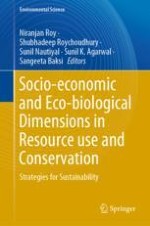Abstract
Jharkhand is one of the biodiversity rich states of India because of its origin, diverse physiographic and climatic conditions. It is well known due to its tribal populations, mineral resources, and its vast forest resources. Forest resources are considered as a commodity of high value across the state as most of the locals are dependent for their daily subsistence needs mainly for food and fuelwood. Forests play an important role in the economic, cultural and social lives and supporting rural livelihoods and food security in Jharkhand. Jharkhand is home to tropical moist deciduous and tropical dry deciduous forests and the dominant plant species like Shorea robusta, Diospyros melanoxylon, Pterocarpus mersupium, Gloriosa superba, Butea monosperma, Madhuca longifolia, etc. Commonly extracted forest produces are timber, fuel wood, fodder, and a range of Non-Timber Forest Products (NTFPs) such as fruits, nuts, edible fungi, vegetables, fish, animals and medicinal plants, resins, essences, and a range of barks and fibers such as bamboo, rattans, palms and grasses. Over-exploitation of useful plants, lack of knowledge and awareness about the plants’ present population status, habitat alteration and specificity, narrow range of distribution, over-grazing are some of the severe threats endangering the existing populations of important plants. Additionally, natural enemies such as pathogens, herbivores and seed predators could substantially limit the abundance of rare plant species in any given area. Collection of plant materials, especially of rare and endangered plant species from natural habitats for various experimental purposes by researchers, also poses a threat on their natural population in the wild. Realizing the continuous depletion of these valuable resources, attempts should be made for its large-scale cultivation and multiplication in order to meet its escalating demand as well as long-term sustainability. There is an urgent need to carry out detailed investigations on the geographical distribution patterns, habitat utilization patterns, feeding ecology, and impact of herbivores on important plant populations.
